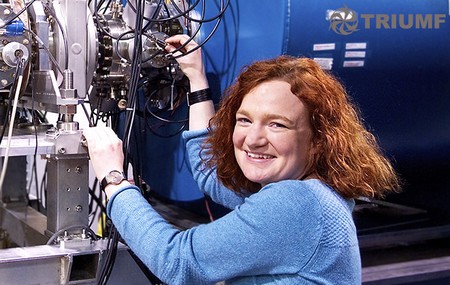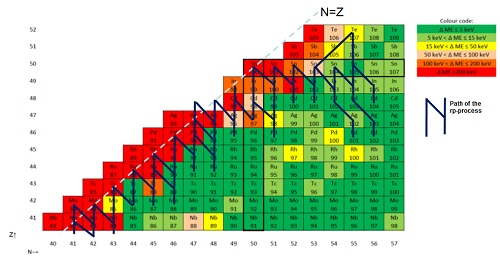Witches’ cauldron prepares magic nucleus for weigh in
Her methods might make physicists shiver, but her background in chemistry could just give Julia Even the edge needed to pull off a remarkable feat: an extremely accurate calculation of the mass of a number of exotic, unstable atomic nuclei. She has just received a EUR 425,000 research grant from NWO to make this happen.
How do you calculate the mass of an atom? That’s not easy, certainly not for atoms that will decay in a matter of seconds or even less. ‘And the accuracy we aim for is very high’, says Julia Even at the KVI-Center for Advanced Radiation Technology (KVI-CART). She points to a picture on her computer of an Airbus 380 and a one eurocent coin. ‘The Airbus weighs 275 tonnes, the coin 2.3 grams. The accuracy we need is the equivalent of weighing the Airbus to see whether there’s a coin inside.’

The nucleus she wants to measure is 100Sn, a ‘doubly magic’ tin atom with a nucleus of 50 neutrons and 50 protons. ‘We call it doubly magic, because the orbits of the neutrons and protons are fully occupied.’ The mass of the neutrons and protons is known at a high level of accuracy, but you can’t just add them up: ‘The binding energy that holds them together affects the mass of the nucleus.’ Theoretical calculations are not very accurate for such unstable nuclei .
Einstein
Even will measure the mass of the nucleus, and will then be able to derive the binding energy that holds it together by using Einstein’s famous E=mc2 formula. The more accurate her mass measurement is, the more accurately she will be able to determine the binding energy. ‘We’ll do this for 100Sn and a number of isotopes surrounding it.’ Even shows a chart with the nuclides coloured in green, orange, yellow or red. The 100Sn and 101Sn are bright red, meaning their mass isn’t known with great certainty. ‘My aim is to make them green.’
Once the mass and binding energy of these unstable nuclei are known with high certainty, nuclear physicists and astrophysicists will be able to refine their models describing how they are formed. ‘This happens inside exploding stars, in a process that’s called rapid proton capture.’ The details of these models will help us understand precisely how the chemical elements that make up our Universe were formed.

So it’s up to Even to measure the mass. There are various methods to do this. Even will use the Penning Trap , a common technique for measuring mass, but it is not straightforward, she explains: ‘100Sn is not stable. It decays in a second, so you have to produce it and send it to the trap.’ This happens in a particle accelerator which shoots a beam of chromium at a nickel foil target. ‘But that produces a number of different nuclei, all with a sum of 100 neutrons and protons.’ The amount of 100Ag (silver) is about 100,000 times that of 100Sn. There will also be a lot of 100Cd (cadmium).
This is where her colleagues came unstuck: how to get those few tin atoms from the nuclide soup? ‘The approach they took was to work as cleanly as possible. They stop tin and all other atoms in a gas catcher, which they keep clean, for example by freezing out the unwanted impurities.’ The results have been disappointing. Even, with her background in chemistry, is taking a radically different approach: ‘I will flood the gas chamber with methane, which binds to both silver and cadmium and will allow me to remove them.’

Witches' cauldron
She will fill the super-clean gas catcher with methane, turning it into a witches’ cauldron. ‘Most physicists are scared to touch chemistry’, she smiles. That’s why she introduced her idea as ‘witchcraft’. The experiments will be conducted at the GSI Helmholtz Centre for Heavy Ion Research in Darmstadt, Germany. The operators won’t just let her add methane to their system. ‘First, I need to prove that it works. The NWO grant will enable me to build a gas catcher to experiment offline, here in Groningen.’ Once she has proved that it does remove the excess silver and cadmium, she can apply for beam time in Darmstadt. ‘And we’ll bring our own gas catcher.’
If she succeeds, it will be a breakthrough in nuclear physics. An entire row of red nuclei going green will deliver many new insights and make lots of her colleagues very happy. She enjoys the work as well: ‘I like measuring mass. It is so much simpler than the alternative, which is to measure an extended spectrum. That requires lots of measurements and even more data analysis. We just do a measurement and get the mass more or less directly.’
| Last modified: | 01 June 2017 3.20 p.m. |
More news
-
10 June 2024
Swarming around a skyscraper
Every two weeks, UG Makers puts the spotlight on a researcher who has created something tangible, ranging from homemade measuring equipment for academic research to small or larger products that can change our daily lives. That is how UG...
-
21 May 2024
Results of 2024 University elections
The votes have been counted and the results of the University elections are in!

